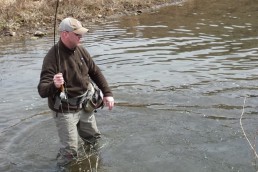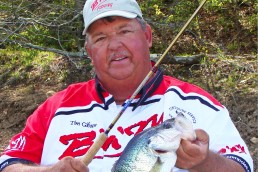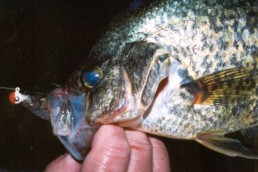Targeting Trophy Trout in Spring
SHARE THIS POST
The past few months I’ve written on the variety of ways to catch trout on a fly rod in the Driftless Area of Minnesota, Wisconsin and Iowa. Much of this information has focused on hatches, the best times of the year and fly patterns. Most larger trout I encounter each year come in March through early in May or late in the year as big browns go on a feeding binge prior to the fall spawn. There are a variety of approaches that anglers will take when targeting the larger, trophy-sized trout in our region.
When I’m going after those elusive larger trout, the first method I use is to simply change things up and put on a heavy leader, typically 4X fluorocarbon, and use larger–than-average patterns.
Andy Roth, a good friend and legendary guide in western Wisconsin, has perfected a variation of Pat’s Rubber Legs using Spanflex to create the undulating legs of the pattern. Spanflex is an inexpensive, stretchy synthetic for legs. In short, the pattern is an oversized stonefly pattern. It’s fished deep with some split shot, and often triggers larger trout into snapping it up. If you don’t have any of the Pat’s Rubber Legs at your disposal try upsizing some of your regular patterns to entice the larger trout.
The other method used when after larger trout in the spring and fall is to fish streamer patterns. Streamer patterns are tied to resemble a large-bite item like a minnow, a small trout or a leech. It is fished very differently than traditional dries or nymphs, as streamers are cast and then stripped through the water column to provoke or coerce a trout into striking the fly.
Are you enjoying this post?
You can be among the first to get the latest info on where to go, what to use and how to use it!
A common pattern for Midwest streamers is the Woolly Bugger. This was the first fly I learned how to tie in my early days simply because it was a large pattern on a large hook and was simple to tie. It doesn’t take a great deal of materials to tie one, so when you lose one or two it’s nothing to worry about. You can tie yours in just about every color imaginable, but I stick with black, brown, dark purple, dark olive or even some red as its main color. Using a bead head is optional, and helps create some weight and flash.
I have modified my Buggers to fit my needs in the Driftless Area, and one is through the hook. I’ve gravitated to curved-shank streamer hooks like TMC200R in sizes 6-8. These hooks are traditionally smaller than typical streamer hooks, but I use them for good reason—many trout that go after a streamer will often strike it, which provides a good bit of entertainment and eye candy for the angler but doesn’t necessarily mean a guaranteed hook-set. Big trout will often follow and then strike a streamer. So, by using a smaller hook and tying the pattern with a shorter tail, I up my chances of actually hooking and landing the fish.
Probably, the easiest Driftless streamer pattern to tie is the marabou leech, which is nothing more than gray turkey marabou as the tail and more marabou wrapped to complete the body. Velcro the fly in a few spots to give it a buggy look, and you’re finished. This pattern has proven very effective all year, and is even a staple summertime pattern. Even when in clean water, the trout will show up for a look or an aggressive take.
The last bit of streamer advice is all about timing. Some of my favorite times to strip streamer patterns are after periods of rain where water clarity is compromised and trout are on the feed. Some stained water will also help conceal you from spooking trout and give you a greater chance to tangle with these Driftless giants.
MWO
SHARE THIS POST
Did you enjoy this post?
You can be among the first to get the latest info on where to go, what to use and how to use it!
Dave Anderson
Dave Anderson has lived in southeast Minnesota his entire life. He started fly-fishing in the early 1990s and has guided ontheflyguiding.com in the area since 1998.



